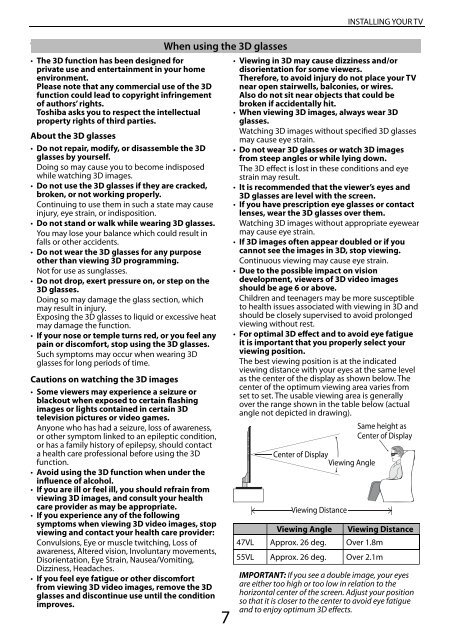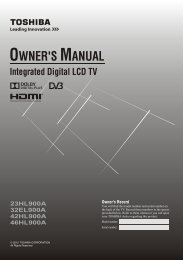You also want an ePaper? Increase the reach of your titles
YUMPU automatically turns print PDFs into web optimized ePapers that Google loves.
\ When using the 3D glasses<br />
• The 3D function has been designed for<br />
private use and entertainment in your home<br />
environment.<br />
Please note that any commercial use of the 3D<br />
function could lead to copyright infringement<br />
of authors’ rights.<br />
<strong>Toshiba</strong> asks you to respect the intellectual<br />
property rights of third parties.<br />
About the 3D glasses<br />
• Do not repair, modify, or disassemble the 3D<br />
glasses by yourself.<br />
Doing so may cause you to become indisposed<br />
while watching 3D images.<br />
• Do not use the 3D glasses if they are cracked,<br />
broken, or not working properly.<br />
Continuing to use them in such a state may cause<br />
injury, eye strain, or indisposition.<br />
• Do not stand or walk while wearing 3D glasses.<br />
You may lose your balance which could result in<br />
falls or other accidents.<br />
• Do not wear the 3D glasses for any purpose<br />
other than viewing 3D programming.<br />
Not for use as sunglasses.<br />
Do not drop, exert pressure on, or step on the<br />
•<br />
3D glasses.<br />
Doing so may damage the glass section, which<br />
may result in injury.<br />
Exposing the 3D glasses to liquid or excessive heat<br />
may damage the function.<br />
• If your nose or temple turns red, or you feel any<br />
pain or discomfort, stop using the 3D glasses.<br />
Such symptoms may occur when wearing 3D<br />
glasses for long periods of time.<br />
Cautions on watching the 3D images<br />
• Some viewers may experience a seizure or<br />
blackout when exposed to certain flashing<br />
images or lights contained in certain 3D<br />
television pictures or video games.<br />
Anyone who has had a seizure, loss of awareness,<br />
or other symptom linked to an epileptic condition,<br />
or has a family history of epilepsy, should contact<br />
a health care professional before using the 3D<br />
function.<br />
• Avoid using the 3D function when under the<br />
influence of alcohol.<br />
• If you are ill or feel ill, you should refrain from<br />
viewing 3D images, and consult your health<br />
INSTALLING YOUR TV<br />
• Viewing in 3D may cause dizziness and/or<br />
disorientation for some viewers.<br />
Therefore, to avoid injury do not place your TV<br />
near open stairwells, balconies, or wires.<br />
Also do not sit near objects that could be<br />
broken if accidentally hit.<br />
When viewing 3D images, always wear 3D<br />
•<br />
glasses.<br />
Watching 3D images without specified 3D glasses<br />
may cause eye strain.<br />
• Do not wear 3D glasses or watch 3D images<br />
from steep angles or while lying down.<br />
The 3D effect is lost in these conditions and eye<br />
strain may result.<br />
• It is recommended that the viewer’s eyes and<br />
3D glasses are level with the screen.<br />
• If you have prescription eye glasses or contact<br />
lenses, wear the 3D glasses over them.<br />
Watching 3D images without appropriate eyewear<br />
may cause eye strain.<br />
• If 3D images often appear doubled or if you<br />
cannot see the images in 3D, stop viewing.<br />
Continuous viewing may cause eye strain.<br />
• Due to the possible impact on vision<br />
development, viewers of 3D video images<br />
should be age 6 or above.<br />
Children and teenagers may be more susceptible<br />
to health issues associated with viewing in 3D and<br />
should be closely supervised to avoid prolonged<br />
viewing without rest.<br />
• For optimal 3D effect and to avoid eye fatigue<br />
it is important that you properly select your<br />
viewing position.<br />
The best viewing position is at the indicated<br />
viewing distance with your eyes at the same level<br />
as the center of the display as shown below. The<br />
center of the optimum viewing area varies from<br />
set to set. The usable viewing area is generally<br />
over the range shown in the table below (actual<br />
angle not depicted in drawing).<br />
Center of Display<br />
Viewing Angle<br />
Same height as<br />
Center of Display<br />
care provider as may be appropriate.<br />
• If you experience any of the following<br />
symptoms when viewing 3D video images, stop<br />
viewing and contact your health care provider:<br />
Convulsions, Eye or muscle twitching, Loss of<br />
awareness, Altered vision, Involuntary movements,<br />
Disorientation, Eye Strain, Nausea/Vomiting,<br />
Dizziness, Headaches.<br />
• If you feel eye fatigue or other discomfort<br />
from viewing 3D video images, remove the 3D<br />
glasses and discontinue use until the condition<br />
improves.<br />
7<br />
Viewing Distance<br />
Viewing Angle Viewing Distance<br />
47VL Approx. 26 deg. Over 1.8m<br />
55VL Approx. 26 deg. Over 2.1m<br />
IMPORTANT: If you see a double image, your eyes<br />
are either too high or too low in relation to the<br />
horizontal center of the screen. Adjust your position<br />
so that it is closer to the center to avoid eye fatigue<br />
and to enjoy optimum 3D effects.











